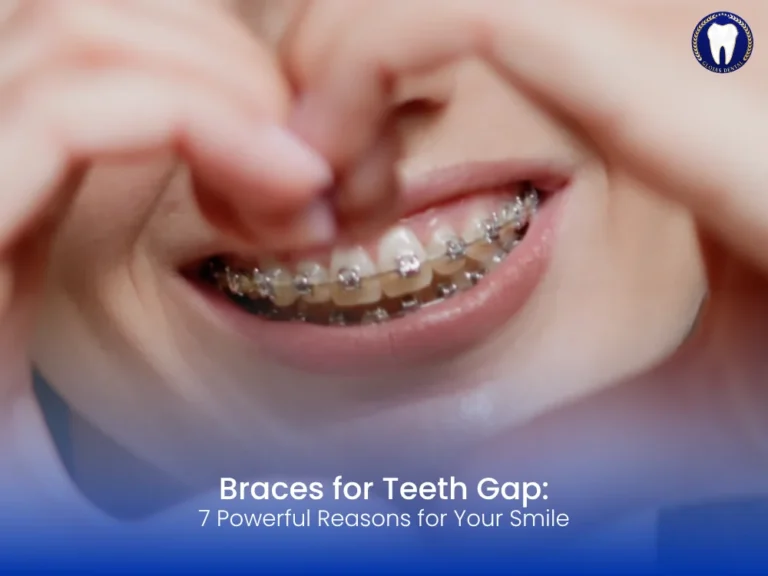A gap between the teeth, especially in the front, can make many people feel self-conscious. This spacing, known as a diastema, is more than just a cosmetic concern—it can affect bite function, oral hygiene, and even speech. The good news? Braces for teeth gap have consistently proven to be one of the most effective and long-term solutions for closing gaps and achieving a healthy, confident smile.
Whether your gap is small or wide, caused by genetics, habits, or missing teeth, there’s a braces solution designed just for you. In this comprehensive guide, we’ll explore how braces work to close teeth gaps, their benefits, types available, and key considerations before choosing a treatment plan.
Understanding Teeth Gaps and Their Causes
Gaps between teeth can occur for various reasons, and identifying the cause helps determine the most suitable treatment.
Common Causes of Gaps:
- Genetics: Some people are born with a mismatch between jaw and tooth size, leading to spacing.
- Thumb Sucking or Tongue Thrusting: These childhood habits can push teeth apart over time.
- Missing Teeth: When a tooth is absent, nearby teeth may shift, creating gaps.
- Gum Disease: Periodontal issues can cause bone loss and tooth movement.
- Oversized Labial Frenum: A thick tissue connecting the upper lip to the gums may create a gap between the front teeth.

How Braces for Teeth Gap Work
Braces apply controlled pressure on teeth to gradually move them into the correct position. Over time, this pressure closes the gaps while also improving alignment and bite function.
Orthodontic Mechanics at Play:
- Brackets are attached to each tooth
- Archwires connect the brackets and apply tension
- As the wire tightens during adjustments, teeth shift closer together
- Elastics or other components may help close specific gaps
Types of Braces for Teeth Gap
Traditional Metal Braces
- Most effective for severe or multiple gaps
- Visible but cost-effective
- Regular adjustments required
Ceramic Braces
- Function like metal braces but use tooth-colored brackets for better aesthetics
- Slightly more expensive and can stain if not cared for properly
Lingual Braces
- Placed behind the teeth, making them invisible from the front
- Require more maintenance and adjustment time
- Ideal for patients prioritizing discreet treatment
Clear Aligners (e.g., Invisalign)
- Removable and virtually invisible
- Best for mild to moderate spacing
- Requires patient discipline to wear 20–22 hours per day
Benefits of Choosing Braces for Teeth Gap
1. Long-Term Effectiveness
Braces offer a permanent solution when paired with proper post-treatment care, such as retainers. Unlike veneers or bonding, braces address the root issue.
2. Improved Oral Health
Closing gaps reduces places where food and bacteria can get trapped, lowering the risk of cavities and gum disease.
3. Enhanced Smile Aesthetics
Once the gaps are closed, the teeth appear more uniform, leading to a confident and attractive smile.
4. Better Speech and Function
Some gaps affect speech or cause tongue interference. Braces correct these issues by aligning the teeth properly.
5. Custom Treatment Options
With multiple types of braces available, patients can choose based on severity, lifestyle, and budget.
6. Boost in Confidence and Self-Esteem
Closing teeth gaps can dramatically improve how a person feels about their smile, enhancing both personal and professional interactions.
7. Preventing Future Dental Problems
Gaps can lead to misalignment over time. Early treatment prevents bite issues and potential jaw problems.
Duration of Treatment for Braces for Teeth Gap
The length of treatment varies based on the size and cause of the gap, patient compliance, and the type of braces used.
Gap Size | Average Treatment Duration |
Small (1–2 mm) | 6–9 months |
Medium (2–4 mm) | 9–12 months |
Large (4+ mm) | 12–24 months |
Follow-up with retainers is crucial to maintain results and prevent teeth from shifting back.
Factors to Consider Before Getting Braces
Age and Timing
Braces are effective at any age, though teeth may shift faster in teenagers due to jaw development.
Oral Health Status
Patients must have healthy gums and teeth before starting orthodontic treatment. Gum disease or decay must be treated first.
Lifestyle and Compliance
Aligners require discipline, while fixed braces need care in brushing, flossing, and avoiding hard foods.
Cost of Braces for Teeth Gap
Costs vary depending on treatment type, location, and severity of the gap.
Type of Braces | Approximate Cost (USD) |
Metal Braces | $3,000 – $5,000 |
Ceramic Braces | $4,000 – $6,000 |
Lingual Braces | $8,000 – $10,000 |
Invisalign | $4,000 – $7,000 |
Dental insurance may partially cover treatment, especially if medically necessary.
Post-Braces: Maintaining the Results
After the active treatment ends, retainers play a critical role in keeping your teeth aligned.
- Fixed Retainers: Bonded behind teeth for long-term results
- Removable Retainers: Worn nightly or as prescribed
Neglecting retainer use may lead to relapse—where gaps reopen over time.
FAQs
1. Are braces the only way to fix teeth gaps?
No. Options like dental bonding or veneers can mask small gaps, but braces are the only solution that moves teeth into proper alignment for long-term results.
2. Do braces for teeth gap hurt?
Mild discomfort may occur, especially after adjustments, but the pain is manageable and usually temporary.
3. Can I choose Invisalign to close my gap?
Yes, if the gap is mild to moderate and your case qualifies. Severe gaps may require traditional braces.
4. Will my gap reopen after braces?
Not if you follow post-treatment protocols, especially wearing retainers as prescribed.
5. How soon will I see results?
Some patients notice progress within the first few months, though full closure takes longer depending on the gap size.
6. Are teeth gaps harmful to oral health?
They can be. Gaps collect food and bacteria more easily, leading to gum problems and tooth decay if not addressed.

